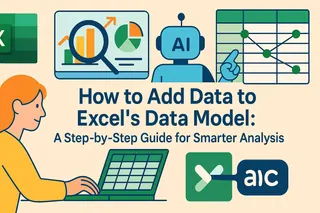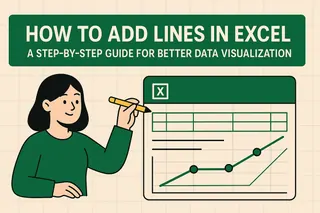Let's be real—looking at a spreadsheet full of naked numbers is about as helpful as a screen door on a submarine. Is that 100 dollars or kilograms? Minutes or miles? Adding units transforms your data from confusing to crystal clear.
At Excelmatic, we eat, sleep, and breathe data clarity. That's why we're sharing these pro techniques to add units in Excel—so your spreadsheets actually make sense at first glance.
Why Bother Adding Units?
Imagine handing your boss a sales report that just says "Revenue: 50000". Is that dollars? Yen? Bitcoin? Without units, your data might as well be hieroglyphics. Here's why unit labels matter:
- Eliminates guesswork for anyone reading your spreadsheet
- Prevents costly misinterpretations (trust us, you don't want to confuse kilograms with pounds)
- Makes your work look polished and professional
The Basic Methods (For Excel Newbies)
1. The Type-It-Out Approach
The simplest way? Just type the unit right after your number: "10 kg", "$25", "30 min". Easy peasy.
But here's the catch—Excel sees these as text, not numbers. So if you need to calculate with these values later, you're out of luck.
2. The Concatenation Hack
Want to keep your numbers as actual numbers? Try this formula:
=A1 & " kg"

This sticks "kg" onto your number while keeping the original value intact for calculations. Drag this formula down your column and boom—instant unit labels.
Pro-Level Unit Formatting
Custom Number Formats (Our Favorite Trick)
This is where Excel really shines. You can make numbers display units while staying fully functional for calculations:
- Select your cells
- Right-click → Format Cells → Custom
- In the Type field, enter:
0" kg"(or whatever unit you need)
Now your numbers show units but still work in formulas. Magic!
Next-Level Excelmatic Magic
While these Excel tricks work, why waste time formatting when you could be analyzing? Excelmatic's AI-powered platform automatically:
- Detects and suggests appropriate units for your data
- Maintains calculation capabilities while displaying units clearly
- Updates units dynamically when your data changes
Instead of wrestling with custom formats, just describe what you need ("Add the unit "$" after all the sales figures.") and Excelmatic handles the rest.
Advanced Unit Management
Conditional Unit Display
Need different units for different values? Set up rules like:
- Show "kg" for values >100
- Show "g" for values ≤100
Excelmatic makes this even easier with smart unit detection that adapts to your data ranges automatically.
Unit Conversion Made Simple
Working with mixed units? Excel's CONVERT function helps:
=CONVERT(A1,"km","mi")
But Excelmatic takes it further with automatic unit standardization—no manual formulas needed.
Common Pitfalls to Avoid
- Inconsistent units: Don't mix kg and lbs in the same column unless you want chaos
- Overcomplicating: Keep your unit systems simple and standardized
- Forgetting updates: If your data changes, make sure your units follow suit
The Excelmatic Advantage
While native Excel offers these unit-adding methods, they require manual setup and maintenance. Excelmatic revolutionizes the process by:
- Automatically detecting when units are needed
- Applying them intelligently without breaking calculations
- Maintaining consistency across your entire dataset
Why waste time formatting when you could be analyzing? Let Excelmatic handle the busywork while you focus on insights that matter.
Final Pro Tips
- Create templates with pre-formatted units for recurring reports
- Use named ranges to make your formulas more readable
- When in doubt, over-label—it's better to be clear than clever
Remember: Great data isn't just accurate—it's understandable. By mastering unit formatting (or letting Excelmatic handle it for you), you'll create spreadsheets that actually communicate rather than confuse.
Ready to take your Excel game to the next level? Excelmatic turns your raw data into polished, unit-perfect reports with AI-powered efficiency. Because your time is better spent analyzing than formatting.






